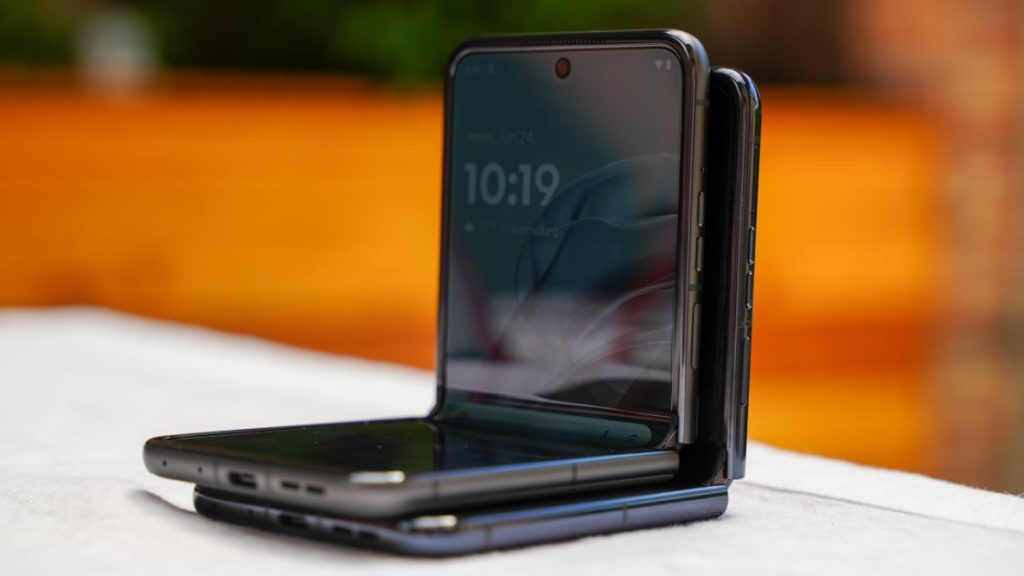Size
One of the most appealing aspects of folding phones like the Z Flip 6 and the Razr+ is how small and pocketable they are. Able to bend in half, they shrink down to pleasing little squares. The difference in size between these two is measured in hundredths of an inch.
The Samsung Flip is slightly more compact than the Motorola Razr+ thanks to its narrower width of 2.83 inches compared with 2.91. Folded, the Z Flip 6 is 3.35 tall, while the Razr+ is 3.47 inches. Both are just 0.60 inches thick. Open, both phones stretch to 6.50 inches long and have nearly the same thickness. At 6.90mm and 6.99mm, the difference is hardly anything to speak of. Not much separates their weight, either: At 6.66 ounces, the Samsung is 0.01 ounces lighter than the Motorola.
Winner: Z Flip 6
Screens
The slightly smaller size of the Z Flip 6 means slightly smaller screens compared with the Razr+. The main screen of the Z Flip 6 is a 6.7-inch Dynamic AMOLED 2X with a 120Hz refresh rate, while the inner screen of the Razr+ is a 6.9-inch AMOLED panel with a 165Hz refresh rate. Both have the same 2,640-by-1,080-pixel resolution, so they’ll be approximately as sharp as each other.

Razr+ (Credit: Eric Zeman)
The real difference is the outside screens, where the Z Flip 6 falls behind the Razr+. The Z Flip 6’s outer screen, called the Cover Screen, is a 3.4-inch Super AMOLED with a resolution of 720 by 748 pixels and a refresh rate of 60Hz. This is totally fine for checking information when your phone is closed. The Razr+, though, has a 4-inch screen with a much higher resolution of 1,272 by 1,080 pixels and a faster refresh rate of 165Hz. That’s far sharper at 417 pixels per inch to the Z Flip 6’s 306.
Winner: Razr+
Power
Even though both phones are brand new, there’s a gap between them where the processor is concerned. The Samsung Z Flip 6 uses the Qualcomm Snapdragon 8 Gen 3 for Galaxy, which is a powerhouse. Moreover, Samsung installed a vapor chamber to help manage thermals and allow the chip to perform at its best.
Motorola opted for a slightly lower-powered chip in the Snapdragon 8s Gen 3, which has wound-down clock speeds compared with the 8 Gen 3.
The Z Flip 6 has the edge in terms of memory, too, with 12GB of RAM compared with the Razr+’s 8GB. The Flip 6 is available with 256GB or 512GB of storage, while the Razr+ only comes with 256GB. Bottom line, the Z Flip 6 has a bit more horsepower and can breathe easier with the vapor chamber.
Winner: Z Flip 6
Cameras
Cameras are where foldable phones usually make compromises compared with rigid flagship phones, and that’s the case for both here. The Z Flip 6 features 50MP f/1.8 standard and 12MP f/2.2 ultra-wide cameras with a 10MP f/2.2 selfie camera—a standard and unambitious configuration.

Galaxy Z Flip 6 (Credit: Eric Zeman)
The Razr+ has two 50MP rear-facing cameras. The main sensor has an aperture of f/1.7 while the 2x optical zoom telephoto has an aperture of f/2.0. The Razr+ has a 32MP f/2.4 selfie camera. All three cameras use pixel binning for final resolutions of 13MP,13MP, and 8MP. The Razr+’s cameras worked well in testing, but didn’t wow us. Samsung’s cameras look similar but we have yet to test them.
Winner: Tie
Battery
Both phones have 4,000mAh batteries, so they might have similar battery life. We won’t know until we test the Z Flip 6, though. Samsung doesn’t provide battery life estimates for its phone, but the Razr+ lasted an impressive 14 hours and 37 minutes in our tests. For reference, however, last year’s Galaxy Z Flip 5 lasted just 10 hours and 5 minutes in our battery stress test. We look forward to confirming a winner here soon.
Winner: Unknown
Durability
Foldables are more expensive than most other phones. Since they have hinges and foldable screens, they necessitate more careful treatment. Samsung has your back here, however, with its Z Assurance policy. All Flip and Fold phones are eligible for one free screen protector replacement and one whole screen replacement at the cost of a standard phone like the Galaxy S24 Ultra. Motorola makes no such assurances.

Galaxy Z Flip 6 (Credit: Eric Zeman)
You don’t have to worry about getting them wet. The Z Flip 6 has an IP48 rating and the Razr+ has an IPX8 rating. The 8 means they’re both completely waterproof in up to 1.5 meters of water for up to 30 minutes. The 4 and X represent dust resistance, meaning the Samsung phone can keep out objects bigger than 1mm, and the Motorola wasn’t tested for dust resistance (though Motorola says its phone is still mostly dust resistant).
Winner: Z Flip 6
Price
Foldable phones still go for a hefty premium. You’ll spend at least $1,000 on either of these models. The Razr+ starts at $999.99, while the Z Flip 6 opens up at $1,099.99 for the 256GB model.
Winner: Razr+
Connectivity
The radio story is a mixed bag here. Starting with cellular connectivity, the Z Flip 6 has both sub-6GHz and faster mmWave 5G while the Moto Razr+ is limited to sub-6GHz. This gives the Z Flip 6 an edge in areas where mmWave service is available.

Razr+ (Credit: Eric Zeman)
Then there’s everything else. The Z Flip 6 has Wi-Fi 6E and Bluetooth 5.3, while the Razr+ has Wi-Fi 7 and Bluetooth 5.4. Wi-Fi 7 can be far faster and more reliable, but it’s also less than a year old, and the few Wi-Fi 7 routers on the market are very expensive. Wi-Fi 6E is no slouch and is still considered a fast, high-end Wi-Fi standard. There are very few differences between Bluetooth 5.3 and 5.4, though the latter supports Miracast.
Winner: Z Flip 6

Galaxy Z Flip 6 (Credit: Eric Zeman)
AI Features
You get some AI tricks with both phones, but Samsung is really pushing its Galaxy AI on the Z Flip 6. Galaxy AI is a suite of tools that includes generative features that can turn portraits or sketches into art. There’s also a Live Translation function that can show different languages on the interior and exterior screens while speaking. The Razr+ has the Gemini Nano chatbot and its own share of Moto AI generative art and photo processing, though we weren’t impressed when we tested its AI art features.
Winner: Z Flip 6
And The Winner Is…

Samsung Galaxy Z Flip 6
Based strictly on specs, the Galaxy Z Flip 6 comes out ahead. It’s smaller, more powerful, more connected, and has better AI features. However, we haven’t fully tested it to see if its benchmarks and battery life impress as much as the Razr+. Motorola’s phone has a larger and more functional outer screen, a larger inner display, and costs $100 less. It could still come out a winner! We’ll update this story as soon as we get a chance to finish testing the Z Flip 6, so make sure to check back.
And remember, Samsung and Motorola aren’t the only companies with folding phones. The Google Pixel Fold and the OnePlus Open are strong options in their own right, despite their high prices.
#Samsung #Galaxy #Flip #Motorola #Razr #Folding #Phone #Flip,
#Samsung #Galaxy #Flip #Motorola #Razr #Folding #Phone #Flip

